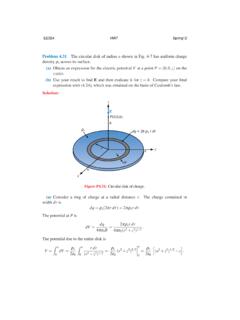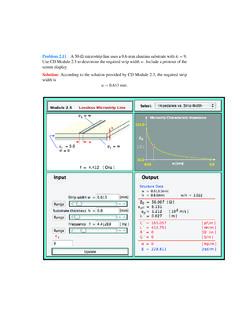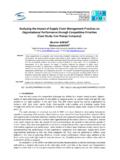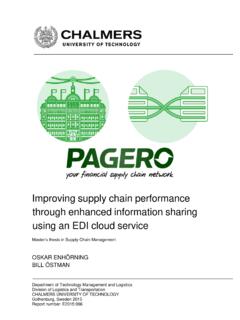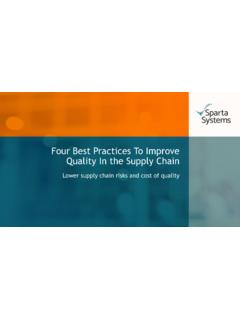Transcription of Cost Characterizations of Supply Chain Delivery ...
1 Cost Characterizations of Supply Chain Delivery performance Alfred L. Guiffrida and Rakesh Nagi* Department of Industrial Engineering 342 Bell Hall University at Buffalo (SUNY) Buffalo, New York 14260 USA Abstract This paper addresses strategies for improving Delivery performance in a serial Supply Chain when Delivery performance is evaluated with respect to a Delivery window. Contemporary management theories advocate the reduction of variance as a key step in improving the overall performance of a system. Models are developed that incorporate the variability found in the individual stages of the Supply Chain into a financial measure that serves as a benchmark for justifying the capital investment required to improve Delivery performance within the Supply Chain to meet a targeted goal.
2 Key Words: improving Delivery performance , Justifying Variance Reduction Paper Received January 2004 Revised October 2004 Accepted January 2005 *Corresponding Author: E-mail: Phone: 716-645-2357 ext. 2103 Fax: 716-645-3302 Cost Characterizations of Supply Chain Delivery performance 1. Introduction In the past three decades, the relationship between customers, manufacturers and suppliers has undergone numerous paradigmatic changes. Modern manufacturing paradigms such as the Just-In-Time (JIT) philosophy, Total Quality Management (TQM) and agile manufacturing, advocate the elimination of non-value adding activities in procurement, production and distribution. The progressive approach espoused by these paradigms is to view individual actions as part of an integrated series of business functions that span across the entire Supply Chain .
3 The goals of Supply Chain management are to reduce uncertainty and risks in the Supply Chain , thereby positively affecting inventory levels, cycle time, processes, and ultimately, end-customer service levels (Chase et al., 1998). Effective Supply Chain administration requires a proactive management style focused on long-term continuous improvement of the Supply Chain . performance measures that accurately reflect Supply Chain operations are required to support continuous improvement within a Supply Chain . Doing so requires the adoption of performance metrics that accurately measure the Supply Chain as a whole, and that focus on measuring performance in terms of cost and uncertainty. Several researchers have expressed concern regarding limitations in Supply Chain performance metrics (see for example, Gunasekaran et al., 2004). These concerns are three-fold.
4 First, performance measures are not cost based. Ellram (2002) identified the lack of relevant performance measures as a key barrier to successful cost management in the Supply Chain . This view is also shared by Lancioni (2000), who observes that as the importance of Supply Chain management grows, it becomes even more imperative for firms to measure the cost performance of their Supply Chain systems. Lalonde and Pohlen (1996) identified a critical need in Supply Chain management for linking performance measurement with cost. Practicing managers in business would agree that cost analysis is important in the management, planning and control of their organizations. Because the metric of cost is easily understood and routinely welcomed by management, cost-based performance measures are attractive for use in Supply Chain management. Cost-based performance measures are compatible across various processes and stages of the Supply Chain .
5 Cost-based measures also provide direct input into the capital budgeting processes used to justify investment in Supply Chain improvement initiatives. In a case study of five firms Ellram (2002) found: 1) cost consciousness is a way of life in the organizations studied, and 2) this philosophy was felt and experienced by all members of the corporation, from the chairman of the board, to the administrative staff, even to the workers on the manufacturing floor. Ballou et al. (2000) cite the ability to define and measure cost among channel members as the first step to analyze the Supply Chain for cost-saving opportunities. 1 Second, performance measures often ignore variability. Variability is inherent in nearly all manufacturing and distributions systems. Managing uncertainty is one of the most important and challenging problems to effective Supply Chain management (Blackhurst et al.
6 , 2004; Sabri and Beamon, 2000). Johnson and Davis (1998) expressed concern that current Supply Chain performance metrics measure attributes that customarily ignore the effects of variability. The reduction of variance is a critical aspect to a methodology designed to improve system performance (Johnson and Davis, 1998; Davis, 1993). Lastly, the adoption of performance metrics that accurately measure the Supply Chain as a whole, and that focus on measuring performance in terms of cost and uncertainty must be integrated into Chain -wide continuous improvement activities. Walker and Alber (1999) note that Supply Chain performance measures continue to be strictly defined in terms that not only optimize local operations, but also reward the individual performance of Chain members. Van Hoek (1998) concludes that current performance measures are designed for single members within the Supply Chain and do not reach across Chain members.
7 Cooper et al. (1997) identify that shortcomings in performance measurement limit improvement projects between Supply Chain members. Therefore, the performance measures used must be formulated to serve as integrating tools for fostering long term, continuous improvement between and within the various stages of the Supply Chain . Aspects of Supply Chain operation that are not measured in understandable performance metrics such as cost will clearly hinder cooperation between the various coalitions found within the Supply Chain structure. performance analysis that is based on cost is not an end in itself. When used in combination with non-cost based measures, such as those found in the balanced score card methodology, cost-based measures, designed to measure processes linking various stages of the Supply Chain , will prove an effective performance measure for long term improvement in Supply Chain operations.
8 Cost-based analysis should be viewed as an ongoing initiative incorporated into a framework that connects functional areas and organizations within the Supply Chain into a reward system for never-ending improvement. In this research we concentrate on one aspect of overall Supply Chain performance , Delivery timeliness to the final customer in a serial Supply Chain that is operating under a centralized management structure. The objectives of this paper are as follows: 1) develop a cost-based performance metric for analyzing Delivery performance within a Supply Chain , and ii) develop a framework for integrating Delivery accuracy and reliability into the continuous improvement of Supply Chain operations. In satisfying the first research objective, a cost-based performance metric for evaluating Delivery performance and reliability will be developed.
9 Delivery lead time is defined to be the elapsed time from the receipt of an order by the supplier to the receipt of the product ordered by the customer. Delivery lead time is composed of a series of internal (manufacturing and processing) lead times and external (distribution and transportation) 2lead times found at various stages of the Supply Chain . Variability in the internal and external components of Delivery lead time is modeled at each stage of the Supply Chain , and the resultant lead time Delivery distribution to the final customer is defined. The Delivery performance measure designed in this research incorporates this uncertainty into a cost-based performance measure. Delivery within the Supply Chain is analyzed with regard to the customer s specification of Delivery timeliness as defined by an on-time Delivery window. To fulfill the second research objective, a methodology is developed that justifies the critical need for organizations to invest capital into the improvement of Delivery performance .
10 The cost-based Delivery performance measure developed herein is integrated into a framework that demonstrates the financial benefit of reducing variability in Delivery performance within the context of a continuous improvement program. This paper is organized as follows. In Section 2, an analytical model based on the expected costs associated with untimely Delivery is developed. In Section 3, propositions are introduced to analyze the Delivery model in terms of its key structural components. In Section 4, Laplace transformations are used to incorporate the time value of money into the model framework to provide a minimum bound in the amount of investment required to improve Delivery performance . 2. Modeling Delivery performance In today s competitive business environment, customers require dependable on-time Delivery from their suppliers.
